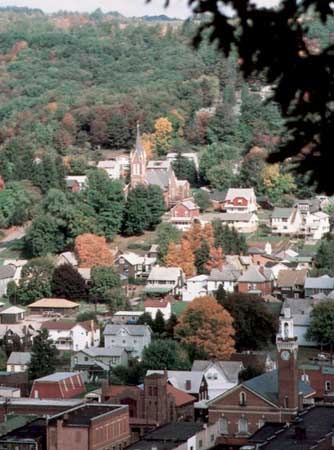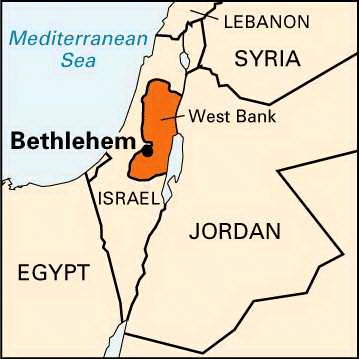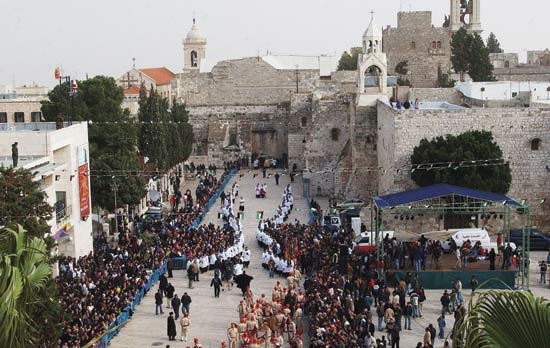Bethlehem
Pennsylvania, United States

 city, Northampton and Lehigh counties, eastern Pennsylvania, U.S. It lies on both sides of the Lehigh River and with Allentown and Easton forms an urban industrial complex. Founded in 1741 by Moravian (Moravian church) missionaries, it received its name from a carol about Jesus Christ's traditional birthplace, sung at Christmas Eve services that same year by the settlers and their German patron, Graf (count) Nikolaus Ludwig von Zinzendorf (Zinzendorf, Nikolaus Ludwig, Graf (Count) von). During the American Revolution, wounded American soldiers were treated in the old Colonial Hall, and British prisoners were quartered in the town. For a short time the Sun Inn was the refuge for members of the Continental Congress, including George Washington (Washington, George), Benjamin Franklin (Franklin, Benjamin), and John Hancock (Hancock, John).
city, Northampton and Lehigh counties, eastern Pennsylvania, U.S. It lies on both sides of the Lehigh River and with Allentown and Easton forms an urban industrial complex. Founded in 1741 by Moravian (Moravian church) missionaries, it received its name from a carol about Jesus Christ's traditional birthplace, sung at Christmas Eve services that same year by the settlers and their German patron, Graf (count) Nikolaus Ludwig von Zinzendorf (Zinzendorf, Nikolaus Ludwig, Graf (Count) von). During the American Revolution, wounded American soldiers were treated in the old Colonial Hall, and British prisoners were quartered in the town. For a short time the Sun Inn was the refuge for members of the Continental Congress, including George Washington (Washington, George), Benjamin Franklin (Franklin, Benjamin), and John Hancock (Hancock, John).One of the first pumped waterworks in North America started operations in Bethlehem in 1754. Industrialization began with the opening of the Lehigh Canal (1829) and its resulting traffic in coal. Bethlehem became a station on the Lehigh Valley Railroad (Lehigh Valley Railroad Company) (1855), and the Saucona Iron Company (now Bethlehem Steel Corporation) was formed April 8, 1857. The north bank borough of Bethlehem (inc. 1845) and South Bethlehem (inc. 1865) were united and incorporated as a city in 1917.
The city's economy was long dominated by the Bethlehem Steel Corporation, but the corporation's last steel mill in Bethlehem closed in 1998. The city's now-diversified economy produces apparel and textile products, machinery, fabricated metal and foundry products, medical equipment and supplies, and chemicals.
The city is the seat of Lehigh University (1865), Moravian College (1742), and Northampton Community College (1966). It has gained a national reputation as a music centre; the first performance in America (1888) of J.S. Bach's St. John Passion gave rise to an annual Bach Festival in May. Moravian traditions are annually observed in the city's Christmas festivities. The tannery (1761) and waterworks (1762) at the colonial industrial area (Historic Bethlehem) have been restored. The Lost River Caverns are nearby. Pop. (2000) city, 71,329; Allentown-Bethlehem-Easton MSA, 637,958; (2006 est.) city, 72,704; Allentown-Bethlehem-Easton MSA, 795,300.
South Africa
town, northeastern Free State province, South Africa, located near the northernmost point of Lesotho, at an elevation of 5,368 feet (1,636 m). Founded in 1860, it was named Bethlehem (“House of Bread”), after its Biblical counterpart, because wheat thrived in the region. The river flowing through the town (since dammed to form Lake Athlone) was named Jordaan. Bethlehem was the temporary seat of the government of the Orange Free State in 1900 during the South African War. The town has railway workshops, cold-storage plants, flour mills, a dairying and malting industry, furniture-manufacturing plants, and textile mills. It is a centre for the distribution of agricultural produce and has major rail, air, and road links. The Pretorius Valley Bird Sanctuary has been created where the Jordaan River passes through Pretorius Valley, and Lake Athlone is a recreation area. Pop. (2001) 11,819.
town in the West Bank
Arabic Bayt Laḥm (“House of Meat”), Hebrew Bet Leḥem (“House of Bread”)

 town in the West Bank, situated in the Judaean Hills, 5 miles (8 km) south of Jerusalem. According to the Gospels (Gospel) (Matthew 2; Luke 2), Bethlehem was the site of the nativity of Jesus Christ. Christian theology has linked this with the belief that his birth there fulfills the Old Testament prophecy of Israel's future ruler coming from Bethlehem Ephrathah (Micah 5:2). Some modern New Testament scholars believe parts of the Gospel accounts to be later accretions and hold that Jesus was born in Nazareth, his childhood home, but normative Christian belief has sanctified Bethlehem as Jesus' birthplace for almost two millennia.
town in the West Bank, situated in the Judaean Hills, 5 miles (8 km) south of Jerusalem. According to the Gospels (Gospel) (Matthew 2; Luke 2), Bethlehem was the site of the nativity of Jesus Christ. Christian theology has linked this with the belief that his birth there fulfills the Old Testament prophecy of Israel's future ruler coming from Bethlehem Ephrathah (Micah 5:2). Some modern New Testament scholars believe parts of the Gospel accounts to be later accretions and hold that Jesus was born in Nazareth, his childhood home, but normative Christian belief has sanctified Bethlehem as Jesus' birthplace for almost two millennia.In the Bible the city is often referred to as Bethlehem Ephrathah, or Bethlehem-Judah. An ancient settlement, it is possibly mentioned in the Amarna Letters (14th-century-BCE diplomatic documents found at Tell el-Amarna (Amarna, Tell el-), Egypt), but the reading there is uncertain. Bethlehem is first mentioned in the Bible in connection with Rachel, who died on the wayside near there (Genesis 35:19). It is the setting for most of the Book of Ruth (Ruth, Book of) and was the presumed birthplace, and certainly the home, of Ruth's descendant King David; there he was anointed king of Israel by the prophet Samuel (I Samuel 16). The town was fortified by Rehoboam, David's grandson and the first king of Judah after the division of the state between Israel and Judah (II Chronicles 11). During the Jewish return to Palestine after the Babylonian Exile (516 BCE and following), the town was repopulated; later a Roman garrison was there during the Second Jewish Revolt (Jewish Revolt, Second) led by Bar Kokhba (135 CE).
 The site of the Nativity of Jesus was identified by St. Justin Martyr (Justin Martyr, Saint), a 2nd-century Christian apologist, as a manger in “a cave close to the village”; the cave, now under the nave of the Church of the Nativity in the heart of the town, has been continuously venerated by Christians since then. St. Helena (Helena, Saint) (c. 248–c. 328), mother of the first Christian Roman emperor ( Constantine I), had a church built over the cave; later destroyed, it was rebuilt in substantially its present form by Emperor Justinian (reigned 527–565). The Church of the Nativity is thus one of the oldest Christian churches extant. Frequent conflicts have arisen over the jurisdiction of various faiths at the sacred site, often incited by outside interests; thus, for example, the theft in 1847 of the silver star marking the exact traditional locus of the Nativity was an ostensible factor in the international crisis over the holy places that ultimately led to the Crimean War (1854–56). The church was later divided between the Greek Orthodox (Greek Orthodox Church), Roman Catholic (Roman Catholicism), and Armenian Orthodox faiths.
The site of the Nativity of Jesus was identified by St. Justin Martyr (Justin Martyr, Saint), a 2nd-century Christian apologist, as a manger in “a cave close to the village”; the cave, now under the nave of the Church of the Nativity in the heart of the town, has been continuously venerated by Christians since then. St. Helena (Helena, Saint) (c. 248–c. 328), mother of the first Christian Roman emperor ( Constantine I), had a church built over the cave; later destroyed, it was rebuilt in substantially its present form by Emperor Justinian (reigned 527–565). The Church of the Nativity is thus one of the oldest Christian churches extant. Frequent conflicts have arisen over the jurisdiction of various faiths at the sacred site, often incited by outside interests; thus, for example, the theft in 1847 of the silver star marking the exact traditional locus of the Nativity was an ostensible factor in the international crisis over the holy places that ultimately led to the Crimean War (1854–56). The church was later divided between the Greek Orthodox (Greek Orthodox Church), Roman Catholic (Roman Catholicism), and Armenian Orthodox faiths.The town has been a monastic centre for centuries; St. Jerome (Jerome, Saint) built a monastery there and, with the aid of Palestinian rabbis, translated the Old Testament into Latin from the original Hebrew (5th century CE). This, together with the New Testament, which he had translated from the Greek before going to Palestine, constitutes the Vulgate, the standard Latin translation of the Bible used by the Roman Catholic Church.
In modern times, Bethlehem was administered as part of the British mandate of Palestine (1920–48; see Palestine: The British mandate (Palestine)); after the first of the Arab-Israeli wars in 1948–49, it was in the territory annexed by Jordan in 1950 and placed in Al-Quds (Jerusalem) muḥāfaẓah (governorate). After the Six-Day War of 1967, it was part of the Israeli-occupied territory of the West Bank (see Arab-Israeli wars). Bethlehem came under control of the Palestinian Authority in the wake of the 1993 Oslo Accords.
Bethlehem is an agricultural market and trade town that is closely linked to nearby Jerusalem. For a long time the town has been important as a pilgrim and tourist centre, although, in the decades following the Six-Day War, tourism and pilgrimage were frequently affected by the ongoing conflict. Several initiatives were undertaken in the early 21st century to encourage local economic development through renewed tourism by Western pilgrims.
The manufacture of religious articles, chiefly of mother-of-pearl, is a traditional industry, as is the carving of olivewood. The town forms a conurbation with adjoining Bayt Jālā, to the northwest, and Bayt Sāḥūr, to the southeast. Bethlehem and its suburbs have many churches, convents, schools, and hospitals supported by Christian denominations the world over. A large proportion of the town's population is Christian. Bethlehem University (1973) offers instruction in both Arabic and English. Pop. (2005 est.) town, 29,019; Bethlehem, Bayt Jālā, and Bayt Sāḥūr conurbation, 60,123.
- Horne, Herman Harrell
- Horne Islands
- Horne, Lena
- Hornemann, Friederich Konrad
- Horne, Marilyn
- Horner, William George
- Horney, Karen
- hornfels facies
- horn fly
- Horniman, Annie
- Hornindals Lake
- hornpipe
- Hornsby, Rogers
- Horn, Shirley
- horntail
- horn-tooth moss
- hornwort
- horny sponge
- horo
- horoscope
- Horowitz, Vladimir
- Horrocks, Jeremiah
- horror film
- horror story
- Horry